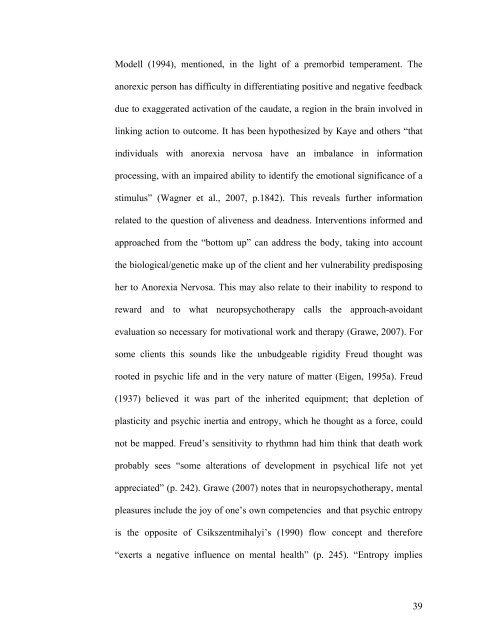“Ghosts at the banquet” - Scholarly Commons Home
“Ghosts at the banquet” - Scholarly Commons Home
“Ghosts at the banquet” - Scholarly Commons Home
Create successful ePaper yourself
Turn your PDF publications into a flip-book with our unique Google optimized e-Paper software.
Modell (1994), mentioned, in <strong>the</strong> light of a premorbid temperament. The<br />
anorexic person has difficulty in differenti<strong>at</strong>ing positive and neg<strong>at</strong>ive feedback<br />
due to exagger<strong>at</strong>ed activ<strong>at</strong>ion of <strong>the</strong> caud<strong>at</strong>e, a region in <strong>the</strong> brain involved in<br />
linking action to outcome. It has been hypo<strong>the</strong>sized by Kaye and o<strong>the</strong>rs “th<strong>at</strong><br />
individuals with anorexia nervosa have an imbalance in inform<strong>at</strong>ion<br />
processing, with an impaired ability to identify <strong>the</strong> emotional significance of a<br />
stimulus” (Wagner et al., 2007, p.1842). This reveals fur<strong>the</strong>r inform<strong>at</strong>ion<br />
rel<strong>at</strong>ed to <strong>the</strong> question of aliveness and deadness. Interventions informed and<br />
approached from <strong>the</strong> “bottom up” can address <strong>the</strong> body, taking into account<br />
<strong>the</strong> biological/genetic make up of <strong>the</strong> client and her vulnerability predisposing<br />
her to Anorexia Nervosa. This may also rel<strong>at</strong>e to <strong>the</strong>ir inability to respond to<br />
reward and to wh<strong>at</strong> neuropsycho<strong>the</strong>rapy calls <strong>the</strong> approach-avoidant<br />
evalu<strong>at</strong>ion so necessary for motiv<strong>at</strong>ional work and <strong>the</strong>rapy (Grawe, 2007). For<br />
some clients this sounds like <strong>the</strong> unbudgeable rigidity Freud thought was<br />
rooted in psychic life and in <strong>the</strong> very n<strong>at</strong>ure of m<strong>at</strong>ter (Eigen, 1995a). Freud<br />
(1937) believed it was part of <strong>the</strong> inherited equipment; th<strong>at</strong> depletion of<br />
plasticity and psychic inertia and entropy, which he thought as a force, could<br />
not be mapped. Freud’s sensitivity to rhythmn had him think th<strong>at</strong> de<strong>at</strong>h work<br />
probably sees “some alter<strong>at</strong>ions of development in psychical life not yet<br />
appreci<strong>at</strong>ed” (p. 242). Grawe (2007) notes th<strong>at</strong> in neuropsycho<strong>the</strong>rapy, mental<br />
pleasures include <strong>the</strong> joy of one’s own competencies and th<strong>at</strong> psychic entropy<br />
is <strong>the</strong> opposite of Csikszentmihalyi’s (1990) flow concept and <strong>the</strong>refore<br />
“exerts a neg<strong>at</strong>ive influence on mental health” (p. 245). “Entropy implies<br />
39
















